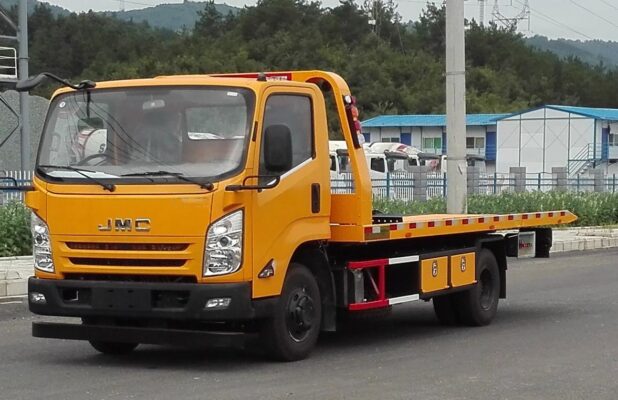CraneS, integral to various construction and industrial tasks, rely heavily on hydraulic power to perform their functions effectively. Given the complexity of hydraulic systems and the critical role they play in dźwig operations, regular maintenance is essential to ensure optimal performance, extend the lifespan of components, and enhance safety. Neglecting these maintenance practices can lead to operational inefficiencies, increased wear and tear, and even catastrophic failures. This comprehensive guide outlines the crucial steps and best practices for the daily maintenance of hydraulic systems in dźwigS.
1. Daily Pre-Operation Checks
Hydraulic Oil Level Check: Before operating the dźwig, it is imperative to check the hydraulic oil level. This can be easily done through the level window located on the oil tank. The hydraulic oil should be filled to the specified level, as indicated by the manufacturer’s markings. If the oil level is found to be below the designated line, it is necessary to replenish the oil before proceeding with operations.
Oil Addition Protocol: When adding hydraulic oil, always use a clean, high-quality filter to prevent contamination. It is crucial to avoid mixing oils of different grades, as this can compromise the performance of the hydraulic system. Furthermore, contaminants such as water, dirt, or debris can lead to severe damage, so ensuring that the oil is clean and appropriate for the system is essential.
2. Oil Filter Maintenance
Regular Filter Inspection: The hydraulic oil filter plays a vital role in maintaining the cleanliness of the hydraulic fluid. It is recommended to inspect the filter element after every 250 hours of operation. During this inspection, check for signs of blockage or excessive contamination. If the filter appears dirty or has reached its capacity, it should be cleaned or replaced as necessary.
Importance of Filter Maintenance: A clean oil filter ensures that the hydraulic system operates efficiently and minimizes the risk of damage to hydraulic components caused by debris. By adhering to this maintenance schedule, operators can prolong the life of the hydraulic system and avoid costly repairs.
3. Drainage and Oil Replacement Schedule
Regular Drainage of Water and Impurities: Hydraulic systems are susceptible to the accumulation of water and impurities, which can settle at the bottom of the hydraulic oil tank. To mitigate this risk, it is advisable to drain the hydraulic oil tank every two weeks. This routine maintenance task helps remove any contaminants and water that could otherwise compromise the hydraulic fluid’s integrity.
Annual Oil Replacement: The entire hydraulic oil should be replaced annually or after approximately 2000 hours of operation. Jednakże, if the oil remains in good condition after this period, the replacement cycle can be extended. Operators should monitor the oil’s clarity and consistency closely, and in particularly harsh operating environments where the risk of contamination is higher, the replacement frequency should be adjusted accordingly.
4. Pressure and Flow Regulation
Factory Settings for Valves: All valves within the hydraulic system are factory-tested and adjusted for optimal pressure and flow before the dźwig leaves the factory. These settings are tailored to the specific hydraulic system’s requirements. It is vital that operators do not tamper with these adjustments casually, as this can lead to imbalances and performance issues.
Importance of Maintaining Proper Settings: Maintaining the factory settings for hydraulic valves ensures that the system operates efficiently and safely. Any modifications made without proper understanding can lead to hydraulic failures, reduced lifting capacity, and increased wear on components.
5. Cleanliness of Hydraulic Components
Dirt and Contamination Prevention: One of the key principles of hydraulic system maintenance is keeping all components clean, particularly those within the hydraulic system. Contamination from dirt, pył, and oil residues can lead to operational inefficiencies and potential failures. After each operation, it is essential to conduct a thorough cleaning of the hydraulic system components to prevent buildup.
Routine Cleaning Practices: Operators should implement regular cleaning protocols that include wiping down hydraulic hoses, fittings, i zawory. Pay special attention to areas where dust and grime may accumulate, as these can introduce contaminants into the hydraulic fluid.
6. Monitoring Performance During Operations
Operational Performance Checks: During daily operations, it is essential to monitor the hydraulic system’s performance continuously. Any irregularities such as unusual noises, leaks, or fluctuations in pressure should be addressed immediately. Early detection of issues can prevent more significant problems and costly repairs.
Operator Training and Awareness: Ensuring that all operators are well-trained and aware of the signs of hydraulic system failure is crucial. Operators should be instructed to report any anomalies to maintenance personnel promptly, fostering a proactive approach to hydraulic system care.
7. Documentation and Record Keeping
Maintenance Logs: Keeping accurate records of all maintenance activities is vital for tracking the health of the hydraulic system. This documentation should include dates of oil changes, filter replacements, and any repairs performed. Maintaining a log allows operators to identify trends, schedule future maintenance, and comply with safety regulations.
Regular Review of Maintenance Practices: Conducting regular reviews of maintenance logs can help identify recurring issues or areas where procedures could be improved. Continuous improvement in maintenance practices contributes to the overall reliability and safety of the dźwig‘s hydraulic system.
8. Conclusion
Daily maintenance of hydraulic systems in dźwigs is not merely a procedural formality but a critical component of safe and efficient dźwig operation. By adhering to the outlined practices—such as regular checks of hydraulic oil levels, diligent maintenance of oil filters, timely drainage and replacement of hydraulic oil, and maintaining cleanliness of components—operators can ensure the longevity and reliability of hydraulic systems.
Ponadto, ongoing training and vigilance from dźwig operators, along with proper documentation of maintenance activities, contribute to a culture of safety and accountability. Podsumowując, effective daily maintenance of hydraulic systems not only enhances the performance of dźwigs but also significantly reduces the risk of accidents and costly downtime in operations. Prioritizing these practices is essential for anyone involved in dźwig operations and maintenance.












